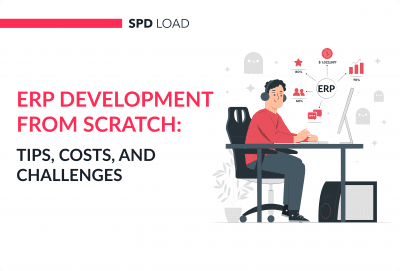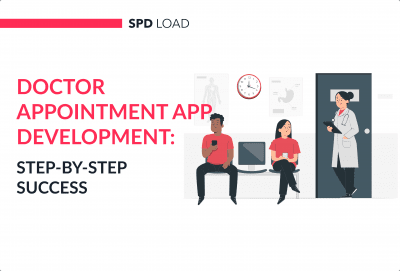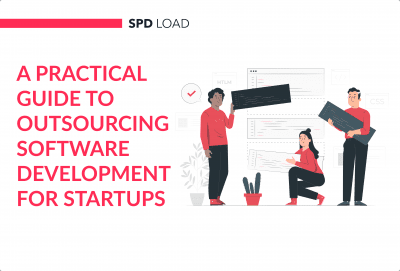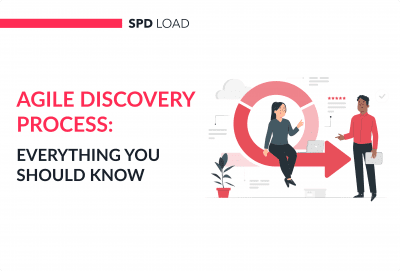How to Make an App: A Step-by-Step Guide for 2025
- Updated: Nov 13, 2024
- 11 min
Ever wish you could launch the next big app startup?
It’s true the mobile app scene is blowing up, with investors betting big bucks on potential new hits. However, crafting a successful startup app carries tons of risk.
The stats don’t lie. Research shows nearly 30% of startups go bust because they run out of cash. And only a tiny fraction ever make it big.
Lots of novice entrepreneurs make preventable mistakes out of the gate. So before diving in head first, start by doing your homework.
Explore practical app development tips to keep your project on track and on budget.
The Idea Generation and Validation Stage
1. Got No Idea Yet? Start Here First
Developing something unique does not always require a lot of fresh ideas. If your dream is to launch an app development for startups, seeking advice and researching the project is okay.
Informative articles like how to start a startup from scratch are your ultimate guide.
- How Do Good Ideas Become Reality?
An excellent technical idea is hard to come by. It takes experience and innovative thinking to bring up game-changing concepts in the mobile application world.
In the product development scenario, no product was at its finest on the first try. But idea generation is, in fact, one of the most crucial stages of starting up your own mobile app.
Here is a comprehensive guide on a how to find idea for a unicorn startup if you’d like to read more about idea generation for your startup.
But what if you already have a unique idea and need guidance on how to turn your vision into reality?
Read on to find how you can get the best out of your vision for your startup initiative.
Explore our comprehensive startup services to navigate through the three crucial stages of planning, development, and launch.
2. Already Got an Idea? Start Here First
Before knowing how you can start your mobile app business, it’s essential to validate the idea. Many mobile app startups, who had great ideas, failed.
It’s unlikely that your startup will succeed if it lacks a clear goal and does not solve users’ problems. You must provide a solution to a common (and long-lasting) problem to stay afloat.
You can avoid this by conducting keyword research, creating a landing page, or sharing a promotional video with your potential customers to collect initial feedback.
Or you can reach out for MVP development services if you have the budget to see how appealing your app will be to users.
Validating a concept is essential since it significantly reduces risk and avoids building something that market does not need.
- A Quick Overview of How You Can Validate the Idea
We understand that letting your inventive ideas flow is appealing. Still, it’s also essential to explore other ideas on how you can improve with your application.
Do not jump in without first testing the waters. Make a list of all the possible ideas you have. It expands your horizon about startup possibilities. It also gives you enough clarity to decide which concept to follow.
You say to yourself I have an app idea and are ready to implement it. But then, you hesitate and are not sure if the idea is worth pursuing. The main thing you should understand if you are determined to create your own startup is that you won’t know if your idea is worthy or not until you go to market with it.
And if you see that there is no potential in your current idea, you will need to propose a new hypothesis for validation.
And iterate until you find an interesting, scalable, and hard-to-copy business model that appeals to investors.
After you’ve established a well-versed vision, you’ll need to document your idea. Offer as much information as possible. The documentation will ensure that your developers get your idea and create the exact mobile app you desire.
As an option, you can use wireframing tools to visualize the killer features and workflows. There are many tools to try. We use Balsamiq in SpdLoad. You won’t have any trouble locating one that you’ll like to give a shot.
Another suggestion is not to dismiss other possibilities. Recognize that there is always room for improvement. Having brainstorming sessions can lead to innovative and unexpected results.
The famous worldwide Figma started as a drone company. But numerous and continuous iterations of product development helped them become the top trendsetter in UX/UI and design.
The app development landscape is evolving. Explore the most important application development trends for your business.
Explore our SaaS services today
If you’d like to know more about idea validation, check out our article. 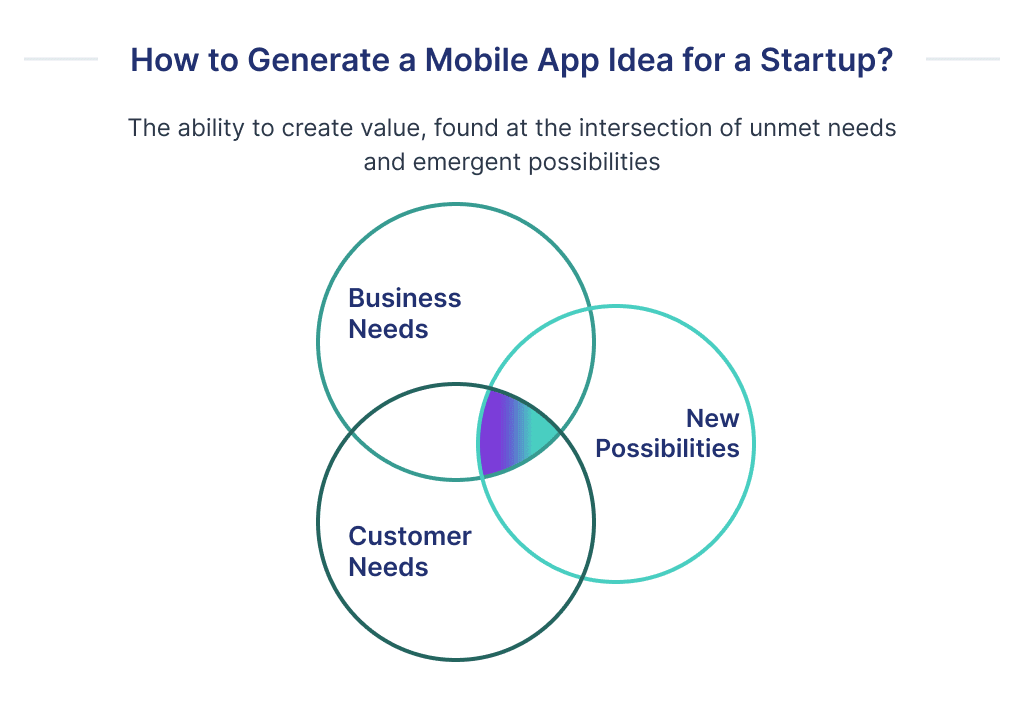
The Building Phase
The next point in the app development stages is to launch the development process. It will require hiring an app project team before you launch a mobile app startup. There are many ways to develop an app development startup.
You must consider people you will collaborate with. A good fit team guarantees that your concept becomes a viable application.
For this, you can either:
- Build an internal team
- Outsource mobile app development to experts
Project Planning
The project discovery phase of application development is pivotal to the survival of your mobile application. It is like strategic planning in some aspects.
This phase strives to generate a shared knowledge of your company’s aims and strategy through in-depth study, debate, and research.
- Phase 1: Research
Before diving into an innovative project like starting a mobile app business, it’s vital to define the potential you’re after and compare it to existing solutions. You need research irrespective of whether your targeted audience is an executive team or a client outside your firm.
- Phase 2: Workshop
You’re prepared to participate in a discovery workshop alongside your chosen app development partner once you’ve gathered as much data as possible about the user’s needs and startup potential. 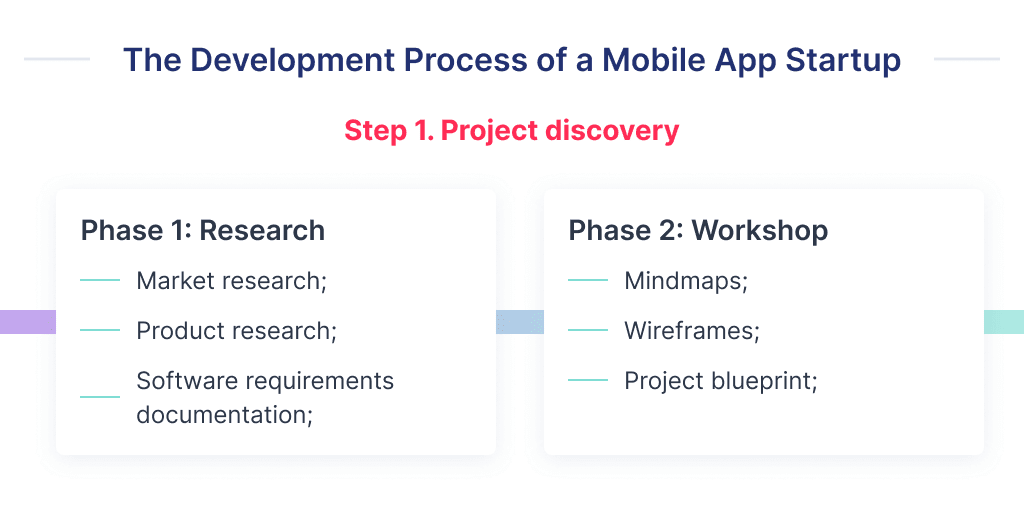
UX/UI Design
“Design is not just what it looks like and feels like. Design is how it works.” – Steve Jobs
The exquisite design with which the apps are developed is the most crucial feature. The app design process lets you conceptualize and improve on your app’s UI (user interface) and UX (user experience) design until you have a finalized template for the developers to build.
- The role of UX
User Experience, or UX, can be described as the design field in which designers seek to improve the user’s entire quality and experience. The app’s user experience influences a user’s view of a mobile app.
UX determines whether the user will return to your app or delete it altogether.
- The role of UI
When we talk about interface design, we’re not only talking about buttons and navigation menus. It’s far more than that. User interface enhances the design and appeal of the application and could partly improve UX.
UI is about form, and UX is about function. When combined, UX and UI can create advanced product usability. 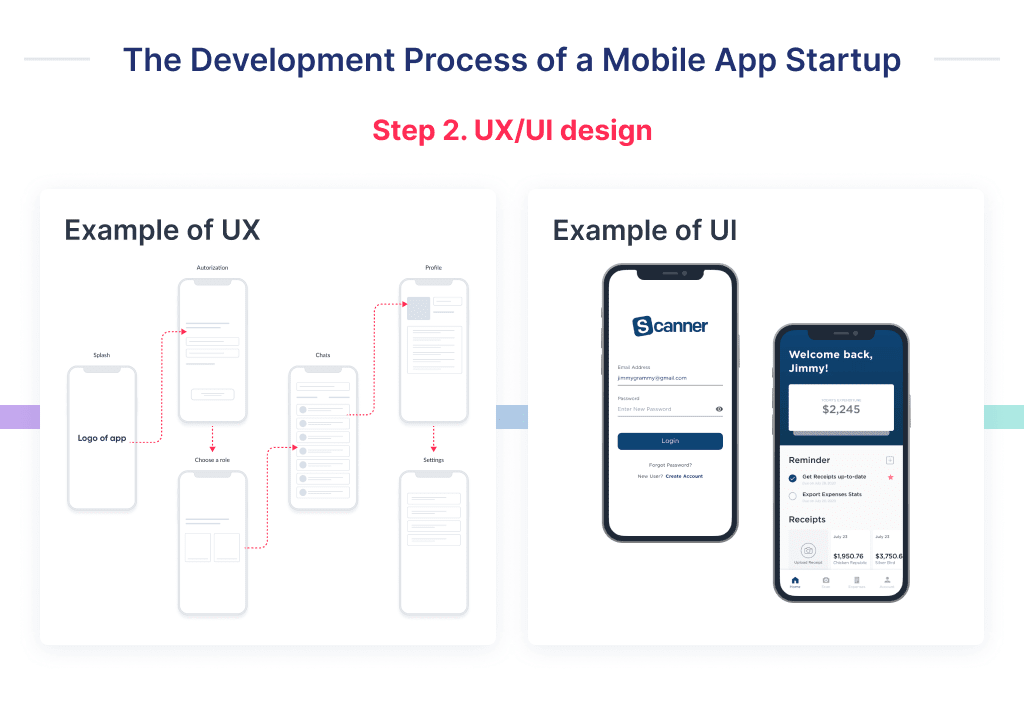
Coding and Testing
The mobile app performance testing stage is essential to ensure that your startup does not gather a negative reputation of ill-functioning apps.
You must thoroughly test the app’s usability, efficiency (safety, speed, resource use, and stability metrics according to standards), and user interface.
- Define the team structure
When deciding how to develop a mobile app startup team, you should first figure out which specialists you’ll need and how many of them you’ll need. The development specialists may consist of the following group:- Project manager
- UX/UI designer
- Mobile developer
- Backend developer
- QA tester
- DevOps (check out our DevOps glossary that covers key terms to help you stay on top of DevOps practices and tools.)
- Development of an MVP
Developing an MVP in business is fundamental to your startup’s success. An MVP has proven to be the go-to solution for mobile app entrepreneurs. It determines whether applications meet the requirement or needs a redo. Also, the cost of developing an MVP is lesser than the full-scalable application. This approach allows you to test the genuine usefulness and importance of your hypothesis/business model:- It is determining whether your intended audience is highly involved in your app
- Receive feedback on improvement opportunities
- Validate the idea before moving forward with more iterations
The development of an MVP literally the technical side of a startup building. Let’s take a look at the coding details.
Android and iOS both allow multiple programming languages. Moreover, there are existing “hybrid” languages, that allow to development of an app for both platforms at the same time.
You must consider switching the languages of your team or technological stack when you start a mobile app business.
iOS apps are written in Objective-C and Swift, whereas Android apps are written in Kotlin and Java. Wondering what it takes to budget for your app? Our breakdown of Android app development costs can help.
If you are interested in iOS development, check out these best iOS development tools.
And React Native or Flutter are used for hybrid app development.
The choice of development language is another vital component in determining how difficult it is to develop your app. It affects the basics of making a mobile app startup, like cost and time of development and your features.
All the stages, as mentioned earlier, will provide you with enough data and startup resources about your application to be successful. 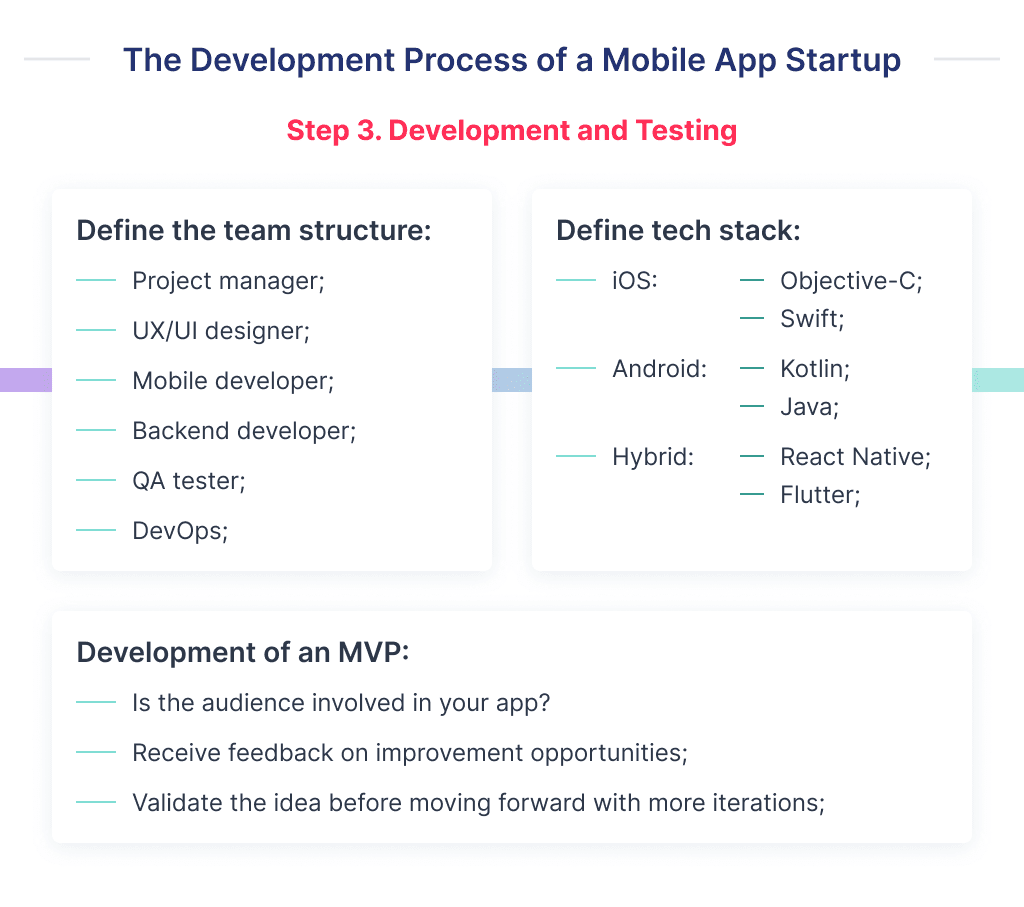
- The Next Step
Now you are confident that the mobile application you have developed is good to go. The next step is to set it up to launch with every idea implemented.
Read our case studies to understand how startups have navigated challenges and achieved success in the competitive app market.
Launching the App
- In-App store
Understanding how to launch a mobile app startup is just as important as developing it. Not only will it facilitate installation, but it will also ensure a consistent level of user loyalty and performance.
A thorough app launch plan is crucial for startups hoping to gain a strategic advantage in the app store.
In addition to online and social media promotion, there are several other things to consider when launching an app.
The key here is App Store Optimization or ASO techniques. These include various aspects of how your app should be optimized to ensure its organic growth. For example, you can test different images, descriptions, use of videos and animations, use of emoji, etc.
As with other aspects, you will generate a hypothesis to test, determine the eligibility criterion, do A/B testing, and then choose the most effective one.
- Collect user feedback
User feedback is an essential component of the product life cycle and the foundation for its evolution. Learn about the issues to consider when adding a feedback module to a mobile app.
And the usual design, development, and overhead costs of various feedback mechanisms.
You can choose any form of feedback platform, including email, questionnaire, forums, polls, and app store reviews.
If you are looking for ways to elevate your email strategy, our email marketing for startups tips are here to help you communicate effectively with your audience.
The next focus area is the final stage of how to start a mobile app business. Continue reading to find out more about this vital step.
Let's shape your startup's product vision together!
The Business Stage
The section on the business of development is at the end of the page. We thought it would be more valuable for you to first look at the aspects of working with ideas and how to implement them.
But business is the leitmotif of startup creation and development. The business aspect is present at every step: from the conception of the idea to the design and development.
Now let’s get back to the point and look at ways and channels to master business development for your startup.
- Launch marketing and sales processes
A profitable company in any field requires an understanding of the target market.
This helps to figure out your sales and promotional strategies better. 99% of startup success lies in impactful marketing and sales strategies.
Yet, without an effective product, it is impossible to create impactful marketing and sales.
The solid strategy lies in understanding your product and targeting the correct audience. Ponder upon questions like what you are selling, why customers should invest their time in your product, who it is for, why they should choose your solution over competitors?
Moreover, there are numerous ways to spread the word including email marketing, mass texting, sponsored ads, etc.
There are a variety of ways to advertise and promote your startup. Besides ASO, there are SEO, SMM, and other marketing channels that can guide you into better marketing. Also, there is always an option to outsource digital marketing to the agency or freelancers.
The way forward with marketing is similar to that of an MVP. You generate a hypothesis, test and measure it through channels, and adjust the assumptions accordingly.
- Think through the unit economy
As a growing startup company, data-driven strategic planning is essential. It ensures that you have the knowledge you need to test your startup’s health and sustainability as you navigate the market.
Using a unit economics approach will help you guarantee that you’re on the right track with your business and that all areas of your SaaS are driving profit and growth.
If you’re deciding between software models, this comparison of the ASP model vs SaaS model can help you choose.
Unit economics measures the revenue of one item of your product. Comparing customer lifetime value (LTV) to customer acquisition costs (CAC) or the present value on CAC are two ways to look at unit economics.
Using a CAC calculator can help you make informed decisions on acquisition strategies.
And to better understand your business’s financial health, our ARR calculator is a valuable tool.
It is vital to start measuring unit economics for your early-stage startup. This gives you the chance to create a clear foundation in your marketplace and attaining positive growth.
- Launch and track product metrics
The MVP should be workable and straightforward to test your hypothesis and learn more about the concept. The secret to our MVP success is:- Identifying your product’s long-term prospects
- Creating a plan to realize that potential
You’ll need analytics that gathers qualitative input on your product’s prospects. Although metrics are commonly thought of as an excellent quantitative analysis method, acquiring qualitative insight does not exclude you from being data-driven. 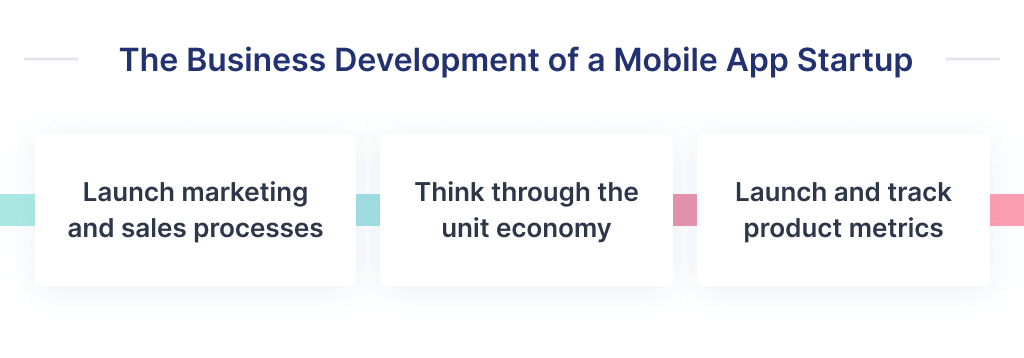
Now you are set with every tip and information about how to start a mobile app startup.
Ready to Build Your Own Startup?
Bringing an app from idea to reality takes careful planning, strategic development, and intuitive design.
As you start your app development journey, an experienced partner can help guide you through the complex process – saving you time and money while unlocking the full potential of your vision.
Learn about the key factors that influence app development costs and how to budget effectively for your project.
If you have a great app idea you’re ready to turn into a reality, we’d love to help.
As a Clutch Leader in Ukraine, we’re excited to bring our clients industry-leading expertise and dedication.
Book a free consultation to discuss your goals and start strategic planning for launching your industry-leading app this year.
Let’s build something revolutionary together!
If you’re entering the SaaS world, these best SaaS startup ideas are worth exploring.





